Vikas Chandra Guddu Baba (53), a lecturer-turned-social activist from Bihar, is responsible for bringing the change when it comes to dignity of the dead
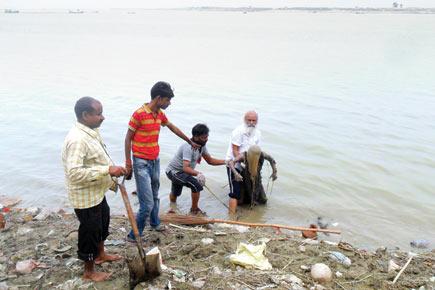
Vikas Chandra Guddu Baba (53), a lecturer-turned-social activist from Bihar, is responsible for bringing the change when it comes to dignity of the dead.
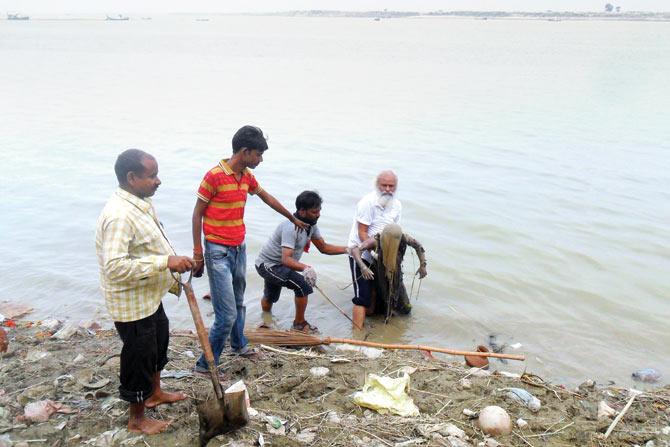
Chandra and helpers fish out a corpse from the Ganga
ADVERTISEMENT
A high-level committee has been constituted by the home ministry to frame guidelines for the dignified disposal of unclaimed bodies as per the directions of a Supreme Court bench comprising of Justice Dipak Misra and Shiva Kriti Singh, hearing a Public Interest Litigation filed by Chandra.
Chandra, who holds a postgraduate degree in Political Science and Public Administration, had taken up a teaching career at a private college in Bihar, but gave it up in 1997.
“I developed an interest in the lives of Agoribabas and would spend time at the Bans Ghat open cremation ground, which touches the Ganga,” said Chandra over the phone from Patna. “This stretch of the Ganga was dirty and looked more like a nullah than the river. One night, I witnessed a man dipping in. He had just cremated his wife and as per rituals had to take a holy dip. The scene disturbed me.”
When Chandra asked the man why he had not taken his boat deep into the cleaner waters, the answer was revealing. “Baba, I am poor and do not have money to hire a boat to take me further inside the Ganga for a holy bath,” he told him.
Moved, Chandra discussed the issue with Captain Vijay Bahadur, a well-known instructor at the Patna Flying club, and launched the clean Ganga campaign in 1999.
“I started visiting the Ganga daily and would collect muck with the help of locals,” said Chandra. “On December 22, 1999, we were on a boat, when a stray dog barked at us from the bank, as it wanted to say something. I was told not to take the boat near the bank, as the dog might attack us, I followed the dog, and to our surprise, it led us to the boundary wall dividing Ganga and Patna Medical College Postmortemcenter.”
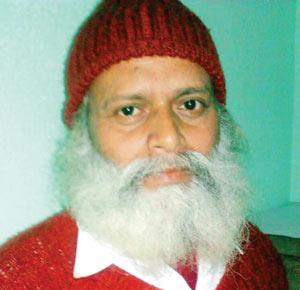
Vikas Chandra Guddu Baba
What Chandra saw there would remain with him for the rest of his life. There were hundreds of decomposed bodies and human remains.
“Luckily, a local photographer, who was accompanying me, took pictures and they were published in local papers. Subsequently, I filed a PIL at the Patna High Court. All the bodies were removed and disposed.”
Since then, Chandra took up the drive of giving a dignified disposal to unclaimed and unidentified corpses and has, over the period, disposed hundreds of abandoned bodies.
He started filing RTIs across the country to various state Directors General of Police asking for information including the number of railway accident deaths, number of people identified and unidentified, how disposal of bodies was done, and who bore the expense.
“Though most of the states replied in English, Maharashtra and Gujarat responded in Marathi and Gujarati, which I could not read. J&K refused to divulge any information. All other states that furnished details for the period 2010-11 and 2011-12 showed that nearly 70,000 accident deaths were declared as unclaimed and unidentified. That makes it 35,000 bodies a year. This prompted me to file a PIL in Supreme Court in 2013, seeking descent disposal of unclaimed and unidentified bodies.”
Chandra is also part of the high level committee constituted by the Supreme Court and has offered his view in the formulation of new guidelines. Disowned by his family, he says, “I have no regrets for what my family did to me. I am determined to expose the wrong. The Central and Bihar governments have not acknowledged my work since they feel I am against the system, but I am only working in the larger interest of society.”
Why Mumbai model is far from ideal

1. On March 13, GT morgue's AC malfunctioned. As the humidity rose, the five male bodies inside began to rot. Residents from nearby buildings complained to the hospital authorities. Technicians arrived two days later.
Recommendations
A senior forensic surgeon jotted a few recommendations for disposal of unidentified and unclaimed bodies.
Mortuary
1. Every mortuary should have two sections for storing bodies.
a) Air-conditioned rooms must be for fresh bodies.
b) Open space for decomposed bodies.
2. The fresh bodies should be kept for 7 days and then cremated in an electric crematorium.
3. Decomposed dead bodies should be immediately sent for burial after autopsy.
4. Every mortuary should be provided with kits and gears for workers. These include gum boots, rubber gloves, face masks.
5. From decomposed bodies, two molar teeth should be extracted and kept for DNA finger printing.
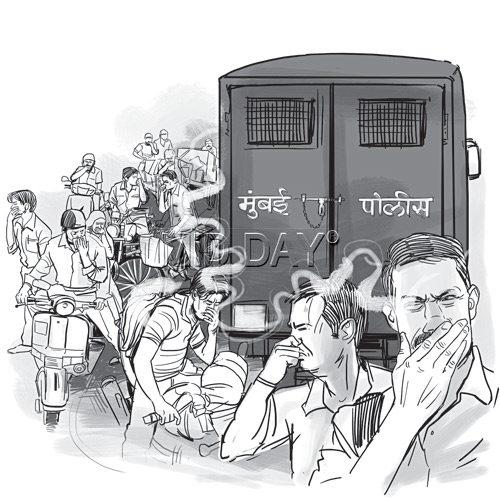
2. As the police hearse van pulled out of GT Hospital at 3 pm, heading to Bhoiwada crematorium five kms away, the stench saw motorists slink away
Police
1. Police should be provided with body bags of plastic or synthetic material for collection and transportation of dead bodies.
2. In the panchanama, the Investigation Officer should mention height, weight, identification marks (tattoos, scars, moles, malformations) of the body.
3. He should take photographs and fingerprints of the deceased.
4. The photographs and details should be forwarded to the Missing Person's Bureau of the Police Department.
5. All police stations should be linked to the Missing Person's Bureau of the Police Department via Internet.
6. If during panchanama, the police believe that the manner of death is natural, the DCP of the area can permit waiving off the PM exam and the body can be handed to a medical college for study.
7. There should be a dedicated hearse van with each post-mortem center.
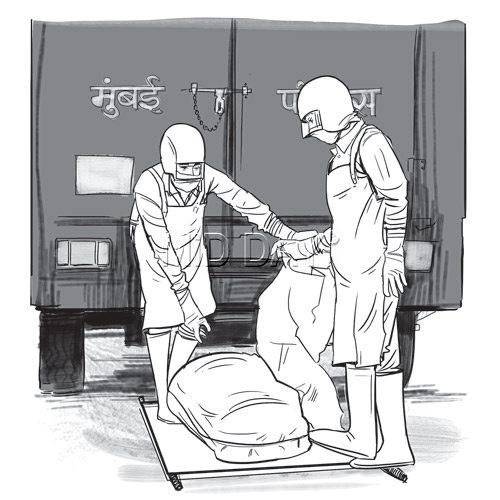
3. The world over, guidelines for disposing of bodies include providing protective gear (boots, disposable aprons, face masks, gloves) to helpers and placing the body in zipped bags. All Kaniya Solanki and Rizwan have are a pair each of torn gloves. Illustrations/Uday Mohite
What he said
Mumbai is one of the few cities to have a proper procedure in place. Since it is the police who dispose the body, the committee members who visited Mumbai to study our procedure applauded our work. Only in cases where there is a doubt is DNA is preserved, and fingerprints and photographs taken by the police to upload on to their website.
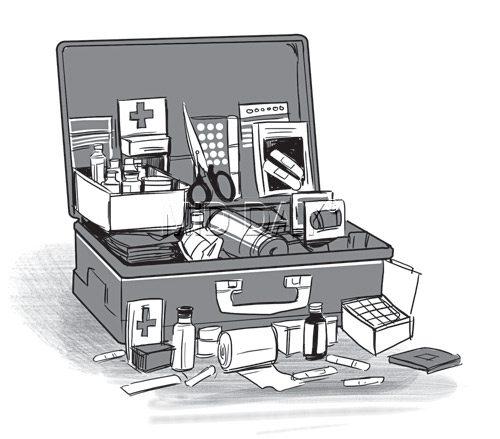
4. World Health Organisation (WHO) suggests that helpers should be vaccinated against tetanus, and medical treatment should be provided to them in case of injury.
What we saw

Dr S M Patil Police Surgeon
When we logged in to the Mumbai police site, the Missing Persons section had details of missing adults (957 entries); no minors, no photos of dead unknown/unidentified bodies posted.
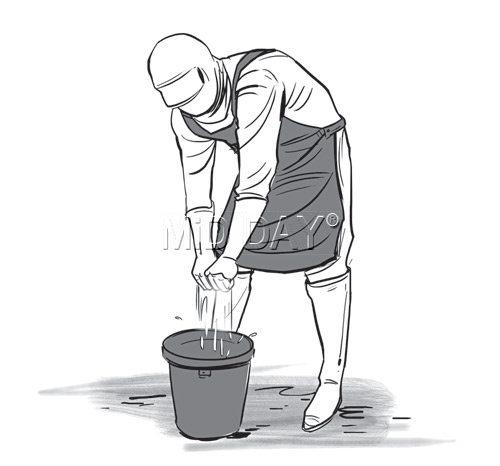
5. WHO guidelines state that helpers should be encouraged to stay free of infection. Kaniya and Rizwan use phenyl available at hospitals to take a shower with it at public toilets inside crematoriums.
 Subscribe today by clicking the link and stay updated with the latest news!" Click here!
Subscribe today by clicking the link and stay updated with the latest news!" Click here!







